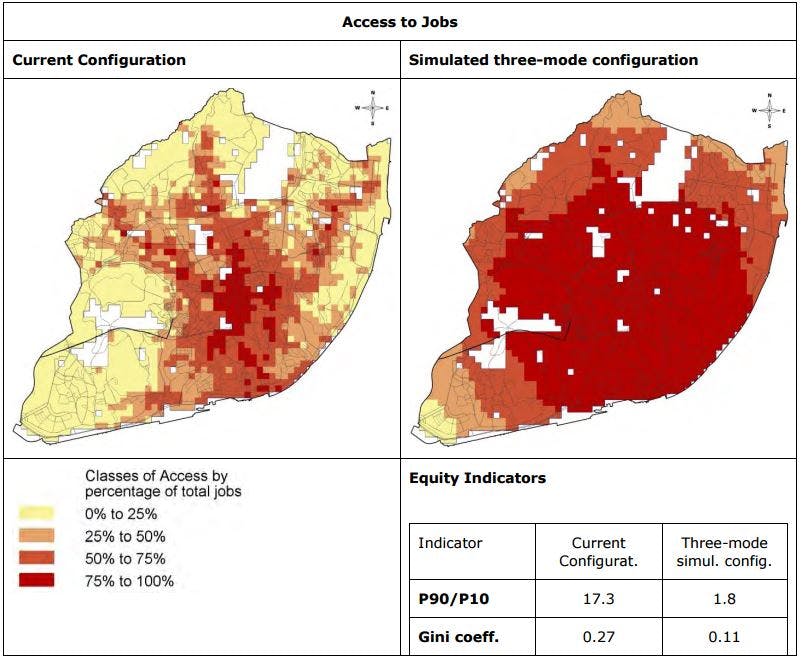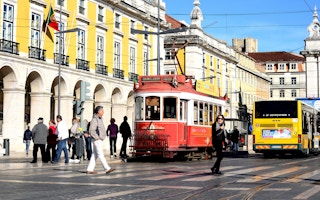Does the way to reducing social inequality lie in a city’s public transport system?
To continue reading, subscribe to Eco‑Business.
There's something for everyone. We offer a range of subscription plans.
- Access our stories and receive our Insights Weekly newsletter with the free EB Member plan.
- Unlock unlimited access to our content and archive with EB Circle.
- Publish your content with EB Premium.
A new report by ITF thinks that it does, and that switching from current public bus services - which have fixed routes and rigid schedules - to on-demand shared vehicles can help more people access jobs, healthcare options and education opportunities at a lower cost.
In the report, titled Shared Mobility: Innovation for Liveable Cities and released on Wednesday, researchers from the International Transport Forum (ITF) at the Organisation for Economic Co-operation and Development (OECD) ran a simulation exercise which used detailed mobility data from Lisbon, Portugal.
They compared existing bus, rail, and metro transport modes to a hypothetical scenario where metro and rail services are complemented by fleets of on-demand eight- or 16-seater taxi-buses, which can be summoned using mobile applications on smartphones.
ITF found that in a shared mobility model, the city’s transport needs could be met by a car fleet that is just 3 per cent of the size of today’s fleet. Each vehicle would also be used more intensively, and the greater efficiency would help cut commute prices by half or more, even without subsidies.
More importantly, it would make it easier for the rich and poor alike to access jobs and other essential services.
Researchers divided the city into a grid of 200-by-200 metre cells, and calculated how many potential jobs, school, and health services citizens in each cell could access within 30 minutes of using public transport.

Access to opportunities with the current public transport system compared to access with an on-demand shared mobility solution.(Red indicates good access, light yellow poor access). Image: International Transport Forum
They then compared how many opportunities the person who was the 10 per cent best-served had compared to the individual at the bottom 10 per cent point, and found that in a traditional public transport system, those at the top 10 per cent mark had more than 17 times as many opportunities as those at the bottom.
But in a shared transport scenario, the more privileged groups had only just about twice as much opportunities as the bottom segment of society, implying greater equality.
Access to health services was even worse in current public transport systems, with the top segments of society having 39 times as much access as the bottom. Shared mobility would, however, bring this ratio down to 2.5, ITF found.
Similarly, in an existing transport framework, the best-served individuals had almost 30 times as much access to opportunities for secondary education and above within a 30-minute commute, but shared mobility would shrink this equality so that the top 10 per cent had only twice as many opportunities as the bottom.
Jose Viegas, ITF’s secretary-general, noted in a statement: “Using transport capacity more efficiently has the potential to build fairer, more inclusive societies by providing broad access to opportunities for everyone.”
Shared mobility also helps the environment, he noted. For one thing, ITF found that if shared taxis and buses were to replace private vehicles or scheduled buses in a city, it would cut greenhouse gas emissions from traffic by one-third. Most of the urban space currently used for parking would also be freed up for other uses.
Because each vehicle was used more intensively - spending 10 hours on the road and clocking 265km of mileage per day - it would also wear out and need to be replaced more quickly, said ITF. This would allow for newer and cleaner technologies to enter the market on a more regular basis.
Despite the evident benefits of shared mobility, the transition from today’s transport system - dominated by fixed-schedule public transit and individual car ownership - to one which uses shared taxis and taxi-buses - can be challenging, ITF noted.
For instance, restricting individual car access to the city would be a good way to get car owners to adopt shared mobility, but this may be difficult to implement. However, it would allow commuters to experience the benefits of shared mobility for themselves.
“
Using transport capacity more efficiently has the potential to build fairer, more inclusive societies by providing broad access to opportunities for everyone.
Jose Viegas, secretary-general, International Transport Forum
Also, traditional bus services may feel threatened by a transition to shared mobility models, and may try to block such changes, warned ITF. But concerns that bus drivers would lose jobs could be easily addressed, because more taxi-buses would be needed on the roads than large-capacity conventional buses. This would mean more, rather than fewer, drivers are needed.
Researchers also predicted that car manufacturers may put up resistance to the changes due to the drastic reduction in number of cars needed on the roads. But these manufacturers should see opportunities for new service-based business models, such as maintaining the shared vehicles and developing more robust interior fittings for them.
“Well-informed and sometimes bold public policies will be necessary to guide the process of change,” said the researchers.
To provide better data and scenarios for policymakers, ITF’s Viegas noted that they will test the analysis model with data from five more cities. “This will help to better understand how to adapt shared mobility solutions so they provide maximum benefit in specific conditions,” he added.










